Campo de' Fiori is one of Rome's most vibrant neighbourhoods in the historic centre. A bustling market by day and rendezvous spot for an evening drink. This is the pulse-point of Rome...
 |
| Campo de' Fiori Market |
Campo de' Fiori, translated from Italian, literally means
"Field of Flowers" because, until the middles ages, this spot
remained a grassy field. Located next to
the floodplains of the Tiber River, the Christian pilgrims coming into Rome to
see the Pope stopped at the open meadow, which served as a thriving
marketplace. The field was paved over in
the mid-1400s to make a piazza or square, as Rome expanded to make room for
Renaissance palaces. The piazza is rustic
and cobblestoned, yet there are elegant palaces such as Palazzo Farnese located
steps away.
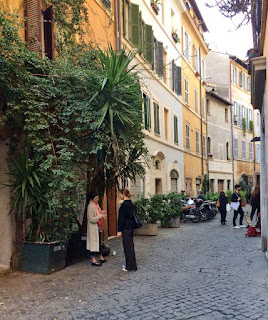 |
| Via dei Cappellari |
TIP: IT'S ALL ABOUT LOCATION, LOCATION LOCATION! When choosing a place to stay in a new city,
I try to find a neighbourhood that is in the oldest part of town but a few
streets over from the main drag. I like
being in a historical center close to restaurants and bars, but far enough away
that loud laughter from an outside patio doesn't keep me awake at night.
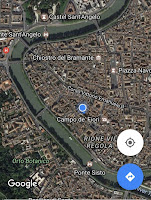
Campo de' Fiori is a Renaissance-style neighbourhood located
between Corso Vittorio Emanuele II and the Tiber River. With it's narrow, winding, cobblestoned
streets, you can imagine being in Medieval Rome. The roads are little alleyways of residential
apartments over charming small independent businesses. This area has been a
commercial zone for centuries; many of the shops have bee run by the same
family for generations.
I often choose an Airbnb apartment on Via dei Cappellari when I come to Rome. Via dei Cappellari means "street of the hat makers" and is one of my favourite streets in the Campo de' Fiori neighbourhood because of the funky architecture and bohemian vibe of the locals. Campo dei Fiori has a long history worth seeking out, including its sad share of public executions. In the center of the piazza, you will notice an imposing statue of a hooded figure looking towards the Vatican. This is Giordano Bruno, who was burned in 1600 on the very spot the statue sits on today.

Bruno was a philosopher, mathematician, poet and cosmological theorist. He had views that built on Copernicus's theory that the Sun is the centre of our Solar System. Bruno's idea was Pluralism; that each star in the sky was a Sun just like ours that it had its own set of planets revolving around them. He believed that these distant planets may also have life, and the Universe was infinite and could have no centre. Giordano Bruno was also a Dominican friar, and he should have known better; the Pope did not like his theories. Bruno was tried by the Vatican starting in 1593 and then burned at the stake seven years later in 1600. He became a martyr to science and, at the base of his statue, reads, "A BRUNO-IL SECOLO DU LUI DIVINATO-QUI DOVE IL ROGO ARSE" which means "To Bruno, From The Age He Predicted, Here Where The Fire Burned."
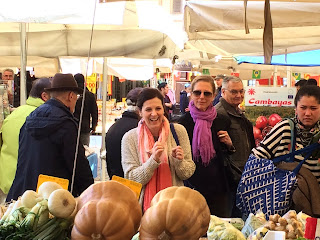 |
| Trying to purchase food in Italian! |
The statue of Bruno was erected in 1889, much to the protest of the Vatican. But the freethinking residents of Campo de Fiori rallied for the figure of Bruno to be erected. This all may sound like a grim memory of the past, but to me, it captures the rebellious and anti-authoritarian, free-spirit of the Campo neighbourhood. As for the Campo de' Fiori market itself, it's a parade of seasonal bounty! For you foodies out there, the market has it all; flowers, fruits, vegetables, spices, fresh pasta, oils, and a bunch of tourist trinkets all mingled in this lovely piazza.

It's lots of fun to try and buy your food at the market,
speaking in Italian. Luckily, I had my
Roman friend, Sara, to guide me. Sara
lives in the Campo de' Fiori neighbourhood, so she shared her favourite veggie
stands, salumeria, cheese shop, and bakery.
TIP: DONT TOUCH THE MERCHANDISE!
This is a big no-no in Italy.
Your vendor will either pick out your produce for you or hold up the
produce for you to approve. If you are
feeling brave, and you would like to try before you buy your "go-to"
phrase, is "Posso provare?" I can try?
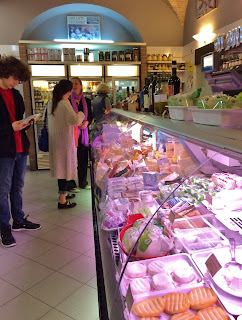 |
| Cheese Shop |
This phrase also works well in the cheese shop, sausage shop, bakery or pastry shop. Here you will want to say, "Posso provare una fetta" A "fetta" is a slice, so you are asking to try a piece. Most of the time, I forget my Italian words; if you just ask "Posso?" and mime an eating motion, the vendors are happy to oblige! The best cheese shop in the neighbourhood is the Formaggi di Gianna & Paola. This is a fantastic cheese shop that also sells other milk products and some gourmet grocery items. The shop is located on the corner of Vicolo del Gallo and Via dei Cappellari as it spills out into the market.
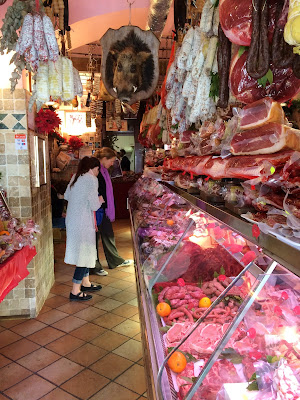 |
Across the street from the cheese is my favourite bakery,
hands down; Forno Campo De' Fiori.
Not only do they make excellent bread, cookies, breakfast rolls, but
amazing pizza too! The building that
houses the Forno is the historical place where Vanozza de' Cattanei ran an inn
while she was the mistress of Pope Alexander VI, who was a Borgia. This bakery is where the infamous Lucrezia
Borgia was born! Lucrezia was the famous
femme fatal who poisoned husbands and lovers while she ruled as the Governor of
Spoleto. Check out my blog post on
Spoleto, Umbria.
Another
staple of the neighbourhood is the Norcineria Viola butcher shop located at #43
Campo de'Fiori. The "Purple
Norcineria" has been selling their delicious Umbrian style sausages from
this location since 1890. A Norcineria
is a butcher who makes pork products in the traditional Norcia, Umbria style,
including wild boar sausage, fennel sausage, liver salami with orange peel and
the most famous, round Umbrian sausage nicknamed Coglione di Mulo or "donkey's
balls."
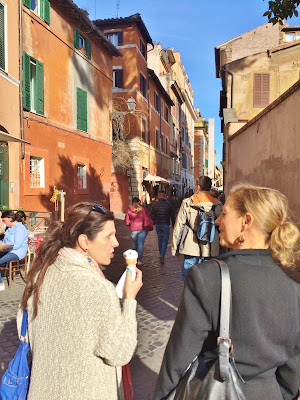 |
| Mobile Treat |
After shopping all those market stalls, cheese vendors, bakeries, pasta shops, pastry shops, butcher shops and wine shops of the Campo de' Fiori, its time for a treat! What would a day in Italy be without gelato!?!
One of the best gelaterias in the Campo is FLOR. Located at the far end of the square from the bakery 51 Piazza Campo de' Fiori. Here you will find authentic artisanal gelato without the addition of artificial colours and flavours that you see in some gelaterias catering to tourists.
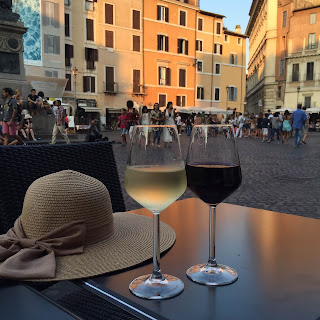
Of course, the tradition in Campo de' Fiori is once the market winds down, to enjoy an aperitivo or pre-dinner drink and snack overlooking the square. You may pay more for your glass at a table on the piazza, but you are paying for scenery and the ambiance~ basically, you pay more for the real estate. But if you some of my money-saving tips I provide in my blog posts (like buying products at the market to prepare in your Airbnb kitchen instead of eating out every meal), you can afford to splurge on a romantic glass of wine on one of Rome's most dynamic piazzas.
Salute!
Do you have any favourite shops in Campo de' Fiori? Or perhaps you have a special memory of the Campo; I would love to hear about it in the comments below!
Follow me on FACEBOOK, INSTAGRAM and BLOGLOVIN' for daily photos and updates! #slowtravel🐌


